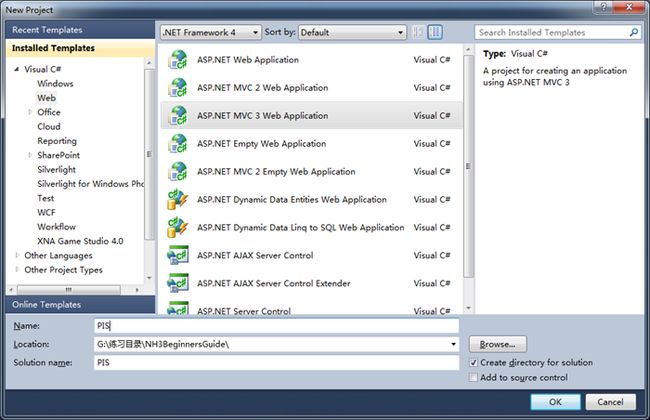NHibernate一个完整的例子
准备开发环境
操作系统:Windows Vista, Windows 7, Windows Server 2003 或 Windows Server 2008
IDE:VS 2010 Professional, VS C# 2010 Express 或 VS Basic 2010 Express
如果不使用Visual Studio,可以使用开源的IDE:
- MonoDevelop,它是是专门为C#和其他.NET语言设计的IDE。可以从这里下载。
- SharpDevelop,它是.NET平台下C#,VB.NET和Boo项目的免费IDE。,可以从这里下载。
数据库:NHibernate支持主流的关系型数据库,像Oracle,MS SQL Server,MySQL等。我们使用MS SQL Server作为我们的RDBMS,在后面写测试时还会使用SQLite。我安装的是MS SQL Server2008 。
准备NHibernate:从Fluent NHibernate下载,就包括程序所需的所有文件。
定义Model
这个例子叫产品库存系统,我们想使用这个程序管理一个小型杂货店的产品列表。产品按类别分组。类别由名字和简短的描述组成。产品有名字,简短描述,类别,单价,重新排序级别,以及一个标识,决定产品是否下架。为了唯一的标识每个类别和产品,它们都有一个ID。如果画一下我们所描述Model的类图,则如下图所示:
注:只有VS的Professional版本类设计器可用,免费的Express版本不可用
下面让我们完成这个简单的产品库存系统(product inventory system)。
1. 在电脑中创建一个文件夹叫NH3BeginnersGuide,在里面再新建一个文件夹叫lib。然后将下载的Fluent NHibernate解压缩到lib文件夹即可。
2. 打开Visual Studio,创建一个ASP.NET MVC 3 Web Application。在弹出的“New ASP.NET MVC 3 Project”对话框选择Internet Application,点击“OK”。
3. 在Models文件夹中 分别创建Category和Product类,代码如下:
public class Category { public virtual int Id { get; set; } public virtual string Name { get; set; } public virtual string Description { get; set; } }
public class Product { public virtual int Id { get; set; } public virtual string Name { get; set; } public virtual string Description { get; set; } public virtual Category Category { get; set; } public virtual decimal UnitPrice { get; set; } public virtual int ReorderLevel { get; set; } public virtual bool Discontinued { get; set; } }
映射Model
定义映射有不同的方法,最常见的方法不是以XML的形式定义就是在代码中定义。在这个例子中,选择后者。
1. 在项目中引用FluentNHibernate.dll和NHibernate.dll。
2. 在Models中分别创建CategoryMap和ProductMap类,让它们都继承自ClassMap<T>类,代码如下:
public class CategoryMap : ClassMap<Category> { public CategoryMap() { Id(x => x.Id); Map(x => x.Name).Length(50).Not.Nullable(); Map(x => x.Description); } }
public class ProductMap : ClassMap<Product> { public ProductMap() { Id(x => x.Id); Map(x => x.Name).Length(50).Not.Nullable(); Map(x => x.Description); Map(x => x.UnitPrice).Not.Nullable(); Map(x => x.ReorderLevel); Map(x => x.Discontinued); References(x => x.Category).Not.Nullable(); } }
创建数据库架构
我们不手动创建数据库架构,而是让NHibernate为我们创建它。我们需要做的只是创建一个空的数据库。
1. 打开SSMS,选择SQL Server身份验证。
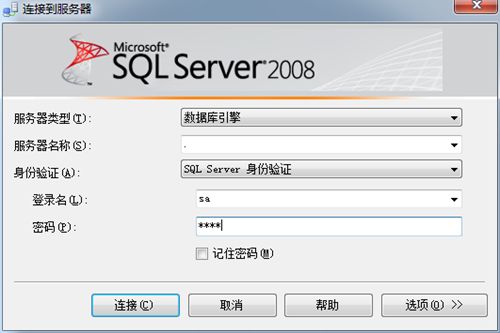
2. 创建一个名字为PIS的空数据库。
3. 在Models文件夹中新建一个NHibernateHelper类,代码如下:
public class NHibernateHelper { public static ISessionFactory CreateSessionFactory() { return Fluently.Configure() .Database(MsSqlConfiguration .MsSql2008 .ConnectionString(c => c.FromConnectionStringWithKey("PISConn"))) .Mappings(m => m.FluentMappings .AddFromAssemblyOf<ProductMap>()).ExposeConfiguration(CreateSchema) .BuildSessionFactory(); } private static void CreateSchema(Configuration cfg) { var schemaExport = new SchemaExport(cfg); //schemaExport.SetOutputFile("c:\\abc.sql"); schemaExport.Create(false,
true
);
}
}
这段代码我不解释,在后面的文章中会详细讲解。其中注释的一行,是NHibernate生成的创建数据库脚本。
4. 打开Web.config,在 <connectionStrings></connectionStrings>节中添加如下代码:
<add name="PISConn" connectionString="Data Source=.;Initial Catalog=PIS;User ID=sa;Password=sasa;Integrated Security=True" providerName="System.Data.SqlClient"/>
5. 新建一个CateogryController,Template选择Empty controller。在Index中添加如下代码:
var factory = NHibernateHelper.CreateSessionFactory();
6. 新建Index的View,运行程序,NHibernate会自动创建好数据库的架构。

在C盘下找到abc.sql文件,里面的代码如下:
if exists (select 1 from sys.objects where object_id = OBJECT_ID(N'[FK1F94D86A856F978E]') AND parent_object_id = OBJECT_ID('[Product]')) alter table [Product] drop constraint FK1F94D86A856F978E if exists (select * from dbo.sysobjects where id = object_id(N'[Category]') and OBJECTPROPERTY(id, N'IsUserTable') = 1) drop table [Category] if exists (select * from dbo.sysobjects where id = object_id(N'[Product]') and OBJECTPROPERTY(id, N'IsUserTable') = 1) drop table [Product] create table [Category] ( Id INT IDENTITY NOT NULL, Name NVARCHAR(50) not null, Description NVARCHAR(255) null, primary key (Id) ) create table [Product] ( Id INT IDENTITY NOT NULL, Name NVARCHAR(50) not null, Description NVARCHAR(255) null, UnitPrice DECIMAL(19,5) not null, ReorderLevel INT null, Discontinued BIT null, Category_id INT not null, primary key (Id) ) alter table [Product] add constraint FK1F94D86A856F978E foreign key (Category_id) references [Category]
7. 创建好数据库的架构后,将schemaExport.Create(false, true); 修改为schemaExport.Create(false, false); 这样程序启动时就不会重新生成数据库的架构了。
实现程序的CRUD
首先,实现插入
1. 在CategoryController中添加Create Action。代码如下:
// //Get: /Category/Create public ActionResult Create() { return View(); } [HttpPost] public ActionResult Create(Category category) { if (category.Name == null) { ModelState.AddModelError("", "类别名称不能为空"); return View(category); } else { var factory = NHibernateHelper.CreateSessionFactory(); using (var session = factory.OpenSession()) { session.Save(category); } return RedirectToAction("Index"); } }
2. 添加对应的View,代码不贴出来了。然后运行,查看效果:
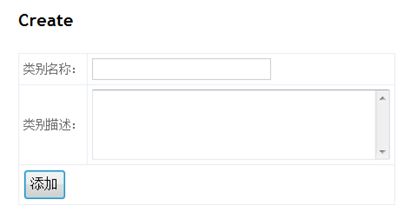
第二,实现查询
1. 修改Index Action。代码如下:
// // GET: /Category/ public ActionResult Index() { var factory = NHibernateHelper.CreateSessionFactory(); IEnumerable<Category> categories; using (var session = factory.OpenSession()) { categories = session.QueryOver<Category>().List(); } return View(categories); }
2. 这个步骤跟上面一样,直接看运行效果:
第三,实现修改
1. 添加Edit Action。代码如下:
public ActionResult Edit(int id) { var factory = NHibernateHelper.CreateSessionFactory(); Category category; using (var session = factory.OpenSession()) { category = session.Get<Category>(id); } return View(category); } [HttpPost] public ActionResult Edit(Category category) { var factory = NHibernateHelper.CreateSessionFactory(); using (var session = factory.OpenSession()) { ITransaction transactioin = session.BeginTransaction(); try { session.Update(category); transactioin.Commit(); } catch (Exception) { transactioin.Rollback(); } } return RedirectToAction("Index"); }
2. 同上,查看运行效果:
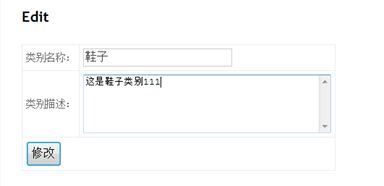
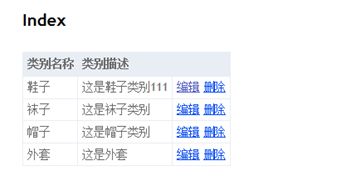
第四,实现删除
1. 添加Delete Action。代码如下:
public ActionResult Delete(int id) { var factory = NHibernateHelper.CreateSessionFactory(); using (var session = factory.OpenSession()) { ITransaction transaction = session.BeginTransaction(); try { var category = session.Get<Category>(id); session.Delete(category); transaction.Commit(); } catch (Exception) { transaction.Rollback(); } } return RedirectToAction("Index"); }
2. 不用添加View了,直接运行,查看结果
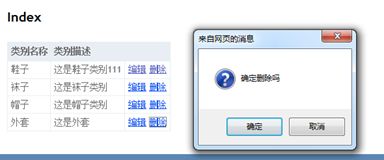
点击确定即可删除记录。
总结
本来想直接翻译NHibernate 3 Beginner's Guid这本书上的例子,最后还是决定自己写个例子吧。这个例子仅仅是实现了功能,没有考虑太多的东西,相当于Hello World吧。上面用到的很多知识,在后面都会详细讲解,因为我也刚刚接触,很多东西也没有弄的太清楚,相信随着学习的不断深入,也会对NHibernate有更深刻的了解。
代码